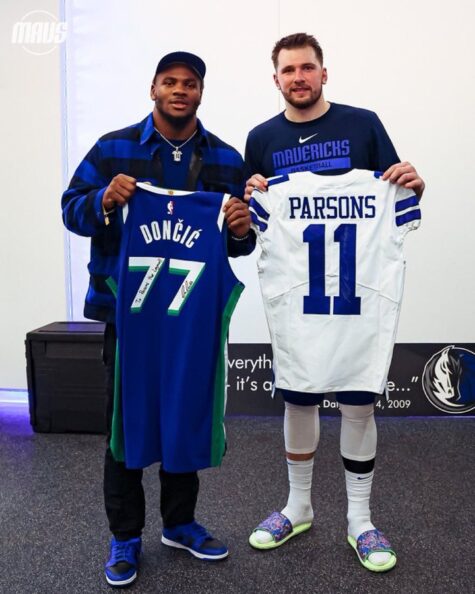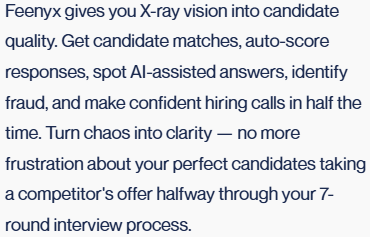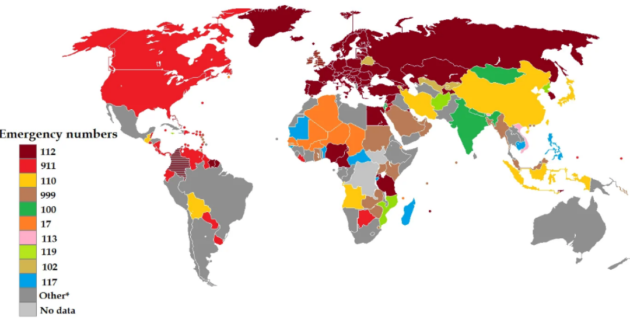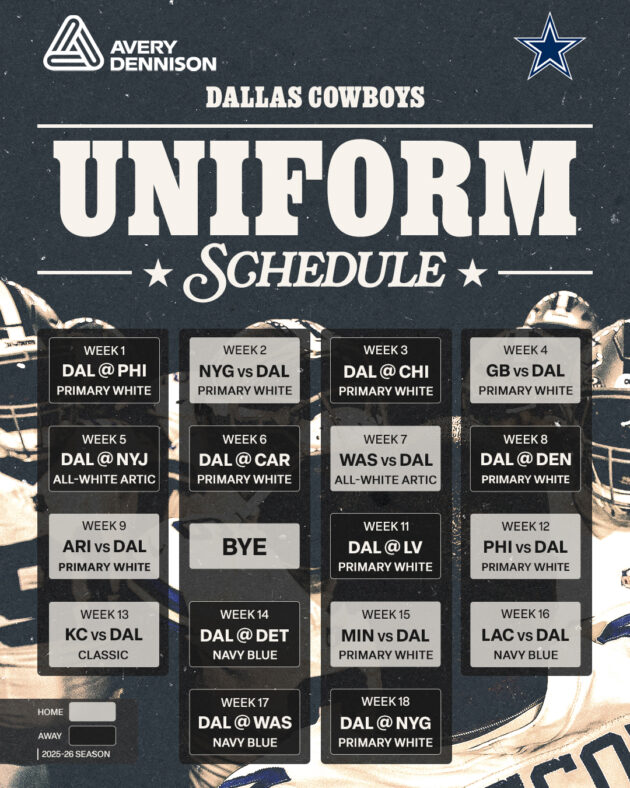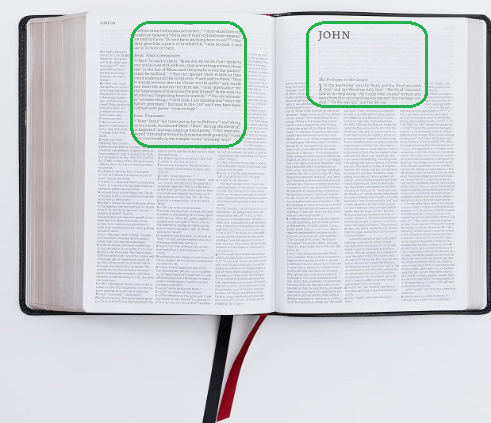The job hunt remains arduous. I’ve had a few interviews, and thought I’d update y’all on how times have changed, at least in my industry as a business analyst.
It seems that every interview involves some component of interacting with AI, and I’m not just referring to AI scanning a resume for keywords. For instance, earlier this week, a recruiter called me to ask me about an employment opportunity. Since I agreed to look at it, he sent me an email with the actual job description.
Since I agreed to move forward, I was asked to take a Feenyx assessment, which is basically an AI tool used by employers. This is how they describe their tool:
The recruiter went on to explain that they get a lot of fake candidates who create AI-generated profiles and then hire cheap labor overseas, so this is their way of preventing that. So, I thoroughly researched Feenyx to gauge others’ opinions about it. Perhaps it appears great from an employer’s perspective, but from a candidate’s perspective, many people have justifiable concerns.
First of all, they want a candidate to install an extension to their browser so that it can track their browser tabs and flags where they may have been using AI. This was a hard no for many people, stating, “Absolutely do not install anything on your personal computer from a potential or actual employer. It’s basically spyware.”
That’s a fair point. For instance, when I installed the plugin, it required permission not only to record audio and video, keystrokes, and the computer screen, but also to access my browser history. There’s no reason why a potential or actual employer should review my personal browsing habits, even if I have nothing to hide. It’s a huge violation of privacy. And if you’re thinking that using Incognito mode or Private Browsing is the answer, note that the tool was designed not to work in those modes. However, I found a decent workaround. I downloaded the Microsoft Edge browser and created a new profile. I then installed the extension only in that new browser, and once I finished the assessment, I deleted the extension, profile, and browser.
Now that I can access the assessment with their extension, I found more privacy issues. It asked me to scan a QR code with my phone, then use my phone to take a picture of both the front and back of my government ID (driver’s license), and scan the barcode on the back of my license. That’s a huge red flag for a lot of people, one person said, “These people are trying to steal PII (Personally Identifiable Information). In no shape or form is doing an initial assessment where you need to show your government ID, which can be stored and copied for a basic assessment.” That’s another fair point, but I went through with it because I’m desperate to find a job after being unemployed for two months. So, I’m at their mercy. After that, it asked me to take a selfie so it could analyze my face and compare it to the photo on my driver’s license.
Finally, it was time to take the assessment. I was asked to answer the following questions while looking into my webcam, as it was recording me and my voice. They were challenging, especially when compared to the BA job description. I showed these to other peers, and the consensus was that they’re more geared toward a senior product manager or DevOps strategist. Here they are:
1. You inherit a C2P backlog where Sales is pushing for a high-visibility feature, while Compliance is pushing a remediation item with unclear scope. In 3 minutes, explain how you would (a) prioritize these items, (b) make the trade-offs transparent to stakeholders, and (c) prepare the next two sprints.
2. You’re asked to introduce secrets scanning and SAST in CI without derailing release velocity. In 3 minutes, outline your rollout plan: pipeline integration points, gating/thresholds, exception handling, stakeholder engagement, and how you’ll measure impact.
3. Product wants CRM “screen pop” and call-disposition sync with a cloud contact center. In 3 minutes, walk through the functional and non-functional requirements you’d capture, the data flows/interfaces, and how you’d validate the solution.
4. The day before production cutover, a critical vulnerability is found in a core dependency. In 3 minutes, explain your decision process to ship, mitigate, or halt using the C2P framework. Include risk assessment, comms, rollback/canary strategy, and prevention steps.
One colleague told me this is designed to stress-test how a person thinks under pressure in real engineering/product situations. That they are essentially executive-level scenario drills, and they’re tough in the sense that:
- They assume experience in Agile prioritization, DevSecOps practices, product integration, and incident response.
- Each question is basically: “Show me how you think strategically, balance trade-offs, and communicate under pressure in 3 minutes.”
- They were dropping you off in the deep end of the pool to see how you react.
He went on to say that most hiring teams know these are incredibly tough questions. They’re watching for:
- Do you show structured thinking (step 1, step 2, step 3)?
- Do you acknowledge trade-offs and risks rather than rambling?
- Do you communicate like a partner to business, not just a coder/tester?
That’s enough to get a “green light” to move forward, even if the technical depth wasn’t perfect.
Oh, and if you are wondering how I did, the recruiter told me my score was “standard,” whatever that means.
Most of the world dials 112 for emergencies. So why did the U.S. end up with 911 instead?
Back in the late 1960s, when rotary phones were still the norm, “1” was the shortest pulse signal on the line — literally one click. Put two of those back-to-back (112) and you risked misdials or interference. That was something I had totally forgotten about – the occasional misdial on the rotary phone. The “9” took real effort to spin, which made it less likely you’d hit it by accident, and the “11” finished things off quickly.
That middle “1” also mattered. In U.S. phone systems, it signaled a special number (think 4-1-1 for information or 6-1-1 for repair). So 911 fit perfectly: fast, distinct, and easy to program.
Fun fact: Most U.S. cell phones will still recognize 112 today and reroute you to 911. And if you want a little telecom trivia, ask someone from Alabama or Alaska who was first to implement 911; both states still claim the crown.
I can’t tell if this is real or AI generated.
Sometimes, The Onion cracks me up with what they can come up with.
Death Of Chopped-Up Woman Ruled A Suicide
— The Onion (@theonion.com) August 28, 2025 at 12:00 PM
How bad was the Micah Parsons trade? Here’s how one Packer fan reacted. First Luka, now Micah. This sports town is cursed with bad ideas; it’s like they are wearing Bad Idea Jeans.
— Annie Agar (@AnnieAgar) August 28, 2025
But hey, here’s the Cowboys uniform schedule for the season.
For no reason at all Jon Hamm and Adam Scott recreated the SIMON & SIMON intro and it’s glorious pic.twitter.com/HwOVw8XJON
— Todd Spence (@Todd_Spence) August 25, 2025
